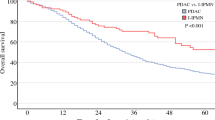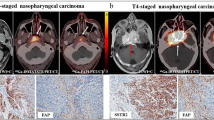Abstract
The aim of this study is to clarify the prognostic value of the pathological overall tumor cellularity after neoadjuvant chemotherapy for locally advanced hypopharyngeal cancer. In consecutive series of 45 operable patients with locally advanced hypopharyngeal cancer, neoadjuvant chemotherapy by cisplatin and 5-fluorouracil was administered. Pathological image analysis was performed in 30 patients using the large cross-section specimen after total resection to evaluate the overall tumor cellularity. The chemotherapeutic responses were classified according to the pathological grading scale by dividing into four categories; more than 70% overall tumor cellularity in Grade 1, between an estimated 10 and 70% in Grade 2, less than 10% in Grade 3, and no identifiable malignant tumor cells in Grade 4. The pathological grades were taken into account for analysis of the survival. In 30 available patients, 40% had Grade 1 pathological response, 30% had Grade 2, and 30% had Grade 3. There was no Grade 4 patient. The overall 5-year survival rate for these 30 patients was 53.33%. The survival rate (61.66%) for patients with Grade 2 and 3 responses was significantly higher than that (27.78%) for patients with Grade 1 response (p = 0.009). Cox regression analysis revealed that the increasing pathological grade was an independent predictor of a better survival in patients undergoing neoadjuvant chemotherapy. We have shown that the prognosis of patients with locally advanced hypopharyngeal cancer, who had been treated by neoadjuvant chemotherapy followed by total resection, can be predicted by evaluation of pathological overall tumor cellularity from the large section specimen.





Similar content being viewed by others
References
Takes RP, Strojan P, Silver CE et al. (2010) Current trends in initial management of hypopharyngeal cancer: the declining use of open surgery. Head Neck (Epub ahead of print)
Lefebvre JL, Chevalier D, Luboinski B, Kirkpatrick A, Collette L, Sahmoud T (1996) Larynx preservation in pyriform sinus cancer: preliminary results of a European organization for research and treatment of cancer phase III trial. EORTC Head and Neck Cancer Cooperative Group. J Natl Cancer Inst 88:855–856
Department of Veterans Affairs Laryngeal Cancer Study Group (1991) Induction chemotherapy plus radiation compared with surgery plus radiation in patients with advanced laryngeal cancer. N Engl J Med 324:1685–1690
Therasse P, Arbuck SG, Eisenhauer EA et al (2000) New guidelines to evaluate the response to treatment in solid tumors. J Natl Cancer Inst 92:205–216
Eisenhauera EA, Therasseb P, Bogaertsc J et al (2009) New response evaluation criteria in solid tumours: revised RECIST guideline (version 1.1). Eur J Cancer 45:228–247
Keberle M, Hoppe F, Dotzel S, Hahn D (1994) Tumor volume as determined by computed tomography predicts local control in hypopharyngeal squamous cell carcinoma treated with primary surgery. Eur Radiol 14:286–291
Chen SW, Yang SN, Liang JA, Tsai MH, Shiau AC, Lin FJ (2006) Value of computed tomography-based tumor volume as a predictor of outcomes in hypopharyngeal cancer after treatment with definitive radiotherapy. Laryngoscope 116:2012–2017
Psyrri A, Kwong M, DiStasio S et al (2004) Cisplatin, fluorouracil, and leucovorin induction chemotherapy followed by concurrent cisplatin chemoradiotherapy for organ preservation and cure in patients with advanced head and neck cancer: long-term follow-up. J Clin Oncol 22:3061–3069
Domenge C, Hill C, Lefebvre J et al (2000) Randomized trial of neoadjuvant chemotherapy in oropharyngeal carcinoma. Br J Cancer 83:1594–1598
Ogston NK, Miller DI, Payne S et al (2003) A new histological grading system to assess response of breast cancers to primary chemotherapy: prognostic significance and survival. Breast 12:320–327
Wang J, Buchholz TA, Middleton LP et al (2002) Assessment of histologic features and expression of biomarkers in predicting pathologic response to anthracycline-based neoadjuvant chemotherapy in patients with breast carcinoma. Cancer 94:3107–3114
Sataloff DM, Mason BA, Prestipino AJ, Seinige UL, Lieber CP, Baloch Z (1995) Pathologic response to induction chemotherapy in locally advanced carcinoma of the breast: a determinant of outcome. J Am Coll Surg 180:297–306
Kuerer HM, Newman LA, Buzdar AU et al (1998) Pathologic tumour response in the breast following neoadjuvant chemotherapy predicts axillary lymph node status. Cancer J Sci Am 4:230–236
Sahoo S, Lester SC (2009) Pathology of breast carcinomas after neoadjuvant chemotherapy. An overview with recommendations on specimen processing and reporting. Arch Pathol Lab Med 133:633–642
Lowe VJ, Dunphy FR, Varvares M et al (1997) Evaluation of chemotherapy response in patients with advanced head and neck cancer using [F-18] fluorodeoxyglucose positron emission tomography. Head Neck 19:666–674
Chien CY, Su CY, Hwang CF et al (2006) Clinicopathologic significance of CD105 expression in squamous cell carcinoma of the hypopharynx. Head Neck 28:441–446
Nishimura T, Newkirk K, Sessions RB et al (1996) Immunohistochemical staining for glutathione S-transferase predicts response to platinum-based chemotherapy in head and neck cancer. Clin Cancer Res 2:1859–1865
Pignon JP, Bourhis J, Domenge C, Designé L (2000) Chemotherapy added to locoregional treatment for head and neck squamous-cell carcinoma: three meta-analyses of updated individual data. MACH-NC Collaborative Group. Meta-analysis of chemotherapy on head and neck cancer. Lancet 18:949–955
Forastiere AA (2004) Is there a new role for induction chemotherapy in the treatment of head and neck cancer? J Natl Cancer Inst 96:1647–1649
Demard F, Chauvel P, Santini J, Vallicioni J, Thyss A, Schneider M (1990) Response to chemotherapy as justification for modification of the therapeutic strategy for pharyngolaryngeal carcinomas. Head Neck 12:225–231
Hitt R, Lo′pez-Pousa A, Martínez-Trufero J et al (2005) Phase III study comparing cisplatin plus fluorouracil to paclitaxel, cisplatin, and fluorouracil induction chemotherapy followed by chemoradiotherapy in locally advanced head and neck cancer. J Clin Oncol 23:8636–8645
Colevas AD, Busse PM, Norris CM et al (1998) Induction chemotherapy with docetaxel, cisplatin, fluorouracil, and leucovorin for squamous cell carcinoma of the head and neck: a phase I/II trial. J Clin Oncol 16:1331–1339
Author information
Authors and Affiliations
Corresponding author
Rights and permissions
About this article
Cite this article
Chitose, Si., Chijiwa, H., Maeda, A. et al. Evaluation of overall tumor cellularity after neoadjuvant chemotherapy in patient with locally advanced hypopharyngeal cancer. Eur Arch Otorhinolaryngol 269, 2391–2399 (2012). https://doi.org/10.1007/s00405-011-1915-1
Received:
Accepted:
Published:
Issue Date:
DOI: https://doi.org/10.1007/s00405-011-1915-1




